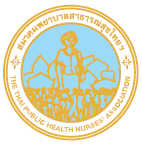The Relationships Between Personal Factors, Pre-Hospital Location and Time to Admittance for Chronic Obstructive Pulmonary Disease (COPD) Patients with Acute Exacerbation
Keywords:
Pre-hospital time, Personal factors, Chronic obstructive pulmonary diseaseAbstract
Acute exacerbation or sudden worsening of COPD symptoms is nowadays quite common in both developed and developing countries and is a crucial incidentce since it may cause sudden death. The purposes of this study were to examine pre-hospital time before seeking treatment and relationships of age, sex, pre-hospital location, symptom awareness and pre-hospital time for chronic obstructive pulmonary disease patients with acute exacerbation. Subjects were one hundred twenty three patients with chronic obstructive pulmonary disease with acute exacerbation at Taksin and Klang Hospitals between 17 September and November 1, 2015., Questionnaires sought demographic information and assessed of pre-hospital time of patients with chronic obstructive pulmonary disease. Descriptive statistics, Chi-Square Test and Eta Correlation were used to represent and analyze data. Results showed that 84.6%of subjects were male andbetween 50 and 59 years. (x ̅= 52.9, S.D. = 5.42). Median scores of pre-hospital time was 60 minutes. (IQR = 30). There were significant relationships between pre-hospital location, symptom awareness, perceived severity and pre-hospital time for chronic obstructive pulmonary disease patients with acute exacerbation (x^2= 12.254, p = .007 ,x^2 = 14.969, p = .010,x^2 = 15.425, p = .000, respectively) Most patients who stayed at home got treatment quickly (68.1%) and family members transfered them to hospital with acute exacerbation (73.8%). There was no relationships between age or sex and pre-hospital time for chronic obstructive pulmonary disease patients with acute exacerbation. Information obtained from this study may be beneficial to nurses in order to develop informational interventions to limit pre-hospital time to treatment at home for chronic obstructive pulmonary disease. Nurses should increase actions to educate patients and , family members to be able to correctly assess signs and symptoms of chronic obstructive pulmonary disease when acute exacerbations occur. This will help increase appropriate self-management and timely treatment.
References
Chaychan P. Chronic Obstructive Lung Disease. In Nithipat J, editors. Respiratory Diseases, Bangkok: Parbpim; 2008. p. 408-443. (in Thai).
The Working Group Develops Guidelines for Chronic Obstructive Pulmonary Disease Services. Health Service Practice Guidelines Chronic obstructive pulmonary disease. Bangkok: Union Ultraviolet; 2010.340-345.
Bureau of Epidemiology, Department of Disease Control Ministry of Public Health. Chronic Diseases Surveillance Report, 2012 [Internet]. 2012 [cited 2014 July 11]. Available from: http://www.boe.moph.go.th/report.php?cat=12.
Nuchanat K. Factors Influencing the Decision Making to Seek Treatment of Patients with Acute Myocardial Infarction. [M.Sc. Thesis in Nursing Science]. Bangkok: Faculty of Nursing, MahidolUniversity, 2006.
Moser DK, Kimble LP, Alberts MJ, Alonzo A, Croft JB, Dracup K, et al. Reducing delay in seeking treatment by patients with acute coronary syndrome and stroke. Circulation. 2006; 114(2): 168-182.
Martínez-García MA, Soler-Cataluña JJ, Perpiñá-Tordera M, Román-Sánchez P, Soriano J. Factors associated with lung function decline in adult patients with stable non-cystic fibrosis bronchiectasis. Chest.2007;132(5):1565-72.
Noraluk U. Health promotion. Bangkok: Faculty of Nursing, Chulalongkorn University; 2010.
Supranee K. Selected factors related to Pre-hospital time in Chronic Obstructive Pulmonary Disease patients with acute exacerbation. [M.Sc. Thesis in Nursing Science]. Bangkok: Faculty of Nursing, Chulalongkorn University, 2016.
Dodd M, Janson S, Facione N, Faucett J, Froelicher ES, Humphreys J, et al. Nursing Theory and Concept Development or Analysis: Advancing the science of symptom management. J AdvNurs. 2001; 33(5): 668-676.
Wiratchai N. Guideline of statistics. 2nd edition. Bangkok: Icon printing; 2012. (in Thai).
Nipaporn P. Factors related to seeking treatment after the onset of acute ischemic stroke patients. [M.Sc. Thesis in Nursing Science]. Bangkok: Faculty of Nursing, Chulalongkorn University, 2008.
De Leeuw, Joop J. Hox, Don A. Dillman. International Handbook Of Survey Methodology. New York: Taylor & Francis, Psychology Press, EAM series; 2008.p.113-135.
Watcharee P. Factors predicting pre-hospital time in patients with acute coronary syndrome. [M.Sc. Thesis in Nursing Science]. Bangkok: Faculty of Nursing, Chulalongkorn University, 2009.
Shephard,T. J. Exploratory investigation of a model of patient delay in seeking treatment after the onset of acute ischemic stroke. [Doctoral dissertation].Virginia Commonwealth University School of Nursing, 2004.
Derex, L., Adeleine, P., Nighoghossion, N., Honnorat, J., Trouillas. Factors influencing early admission in a French Stroke Unit.[Internet]. 2008 [cited 2014 July 29]. Stroke [Online]. Available from: http://www.strokeaha.org.
Downloads
Published
How to Cite
Issue
Section
License
บทความที่ตีพิมพ์และแผนภูมิรูปภาพถือเป็นลิขสิทธิ์ของวารสารพยาบาลสาธารณสุข (Thai Public Health Nurses Association)







